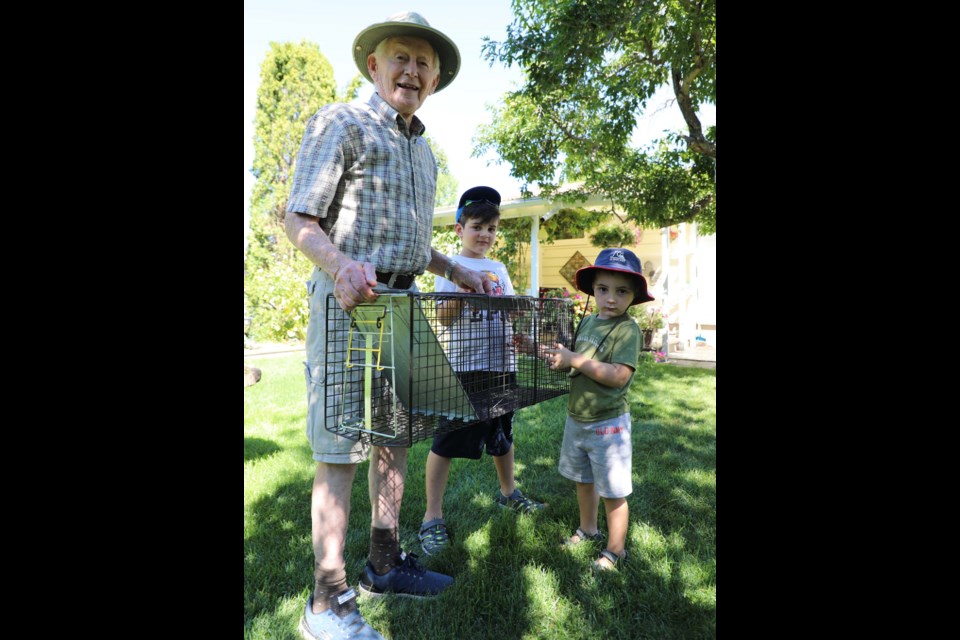The trick to catching porcupines is salted apples and a couple of strawberries, according to five-time porcupine catcher Douglas Wilson.
“I'm not sure whether one came back or not, but he seemed to be leery of the trap. I had to lead him into it gradually — salted crackers, salted apples. To begin with, I just had apples, and he wouldn't go into the trap … then I put a strawberry at the front of the trap and one at the back.
“And that's my magic,” he said.
Douglas and his wife Irma have lived in St. Albert for the last 60 years, but it has only been the last couple of years that porcupines have been raiding their garden.
“They show up when the raspberries get their new growth and the roses. [The porcupines] also, [enjoy] beet tops,” said Douglas.
Douglas, along with neighbour Dana Hurley, has caught five porcupines — mostly in his yard — since 2020, with two of the spiky bandits caught this spring and early summer.
Hurley was one of the first people to notice they had the beginnings of a prickly problem.
“A couple of girlfriends and I were sitting outside in the evening, and [the porcupine] was up high in those trees there,” Hurley motioned. “We're like, ‘What is that?’ And one of my girlfriends — she's not scared of nature — she went over there and she's like, ‘Oh my gosh, it's a porcupine,' and I didn't know they climb trees.”
Kevin Veenstra, a tree and pest foreman for the city of St. Albert, said porcupines love trees.
“If you're fortunate enough to them have visit your place … they’ll climb right up the trees. They love the trees,” he said.
Veenstra said porcupines typically follow the fruit trees in the summer and in the deep winter months they can be found in the spruce, pine, and evergreen trees.
“They’ll de-bark everything. We’ve lost quite a few trees,” said Veenstra.
Porcupines, Veenstra said, are quite detrimental to landscape and can also be a huge problem for pets.
Veenstra said he relocates about four to six problem porcupines per year.
In the past, many years ago, Veenstra said the city would drop them off at Riverlot 56.
“I think we just created our own problems. Now we take them far away into a nature conservancy,” he said.
Hurley said they called Alberta Fish and Wildlife and the city about their initial porcupine sighting and were told neither would do anything about porcupines on private property.
So they, along with the Wilsons, bought a trap.
Douglas said he takes the porcupines out to Glory Hills about 35 kilometres away.
“It's beautiful up there. It's wild. There's lots of water. There's lakes. It was a great place for [porcupines], I thought. So, I give them a ride out there,” he said.
“They will come back if you don't take them a good distance,” said Douglas.
Veenstra said if a homeowner finds a porcupine on their property, the homeowner should carefully protect themselves and corner it into a garbage can with a hockey stick or something similar.
“They are not aggressive animals. Typically, we drop a garbage can down and then with a hockey stick push them into the garbage can, pick it up, and take it for a drive. That’s how easy it is,” he said.
The city does have traps, but there can be a wait list for them.
If a person is trapping a porcupine, Veenstra has his own recipe — pineapple and salt.
“They love salt. They have this thing about salt. They have an insatiable appetite for salt. Just put a chunk of road salt with pineapple in a live trap and [you've] pretty well got them,” he said.
As for relocation, it is important that people call the Nature Conservancy of Canada to see where to drop off the porcupines.
“Get permission, otherwise people don't like you delivering your problems to them in their area. Permission is a big thing for relocation,” Veenstra said.
Other tips Veenstra has for residents is to have good fences, and if people don’t like animals, they should not be growing fruit, because porcupines love fruit.
Douglas said the porcupines he caught filled the cage with their puffed-out quills, and they were anxious to escape, but he was not concerned because they don’t throw their quills, as some people believe.
“I haven't seen any signs [of porcupines] since [the last one] so it'd be interesting what we see next year. But we have a trap ready,” said Douglas.




